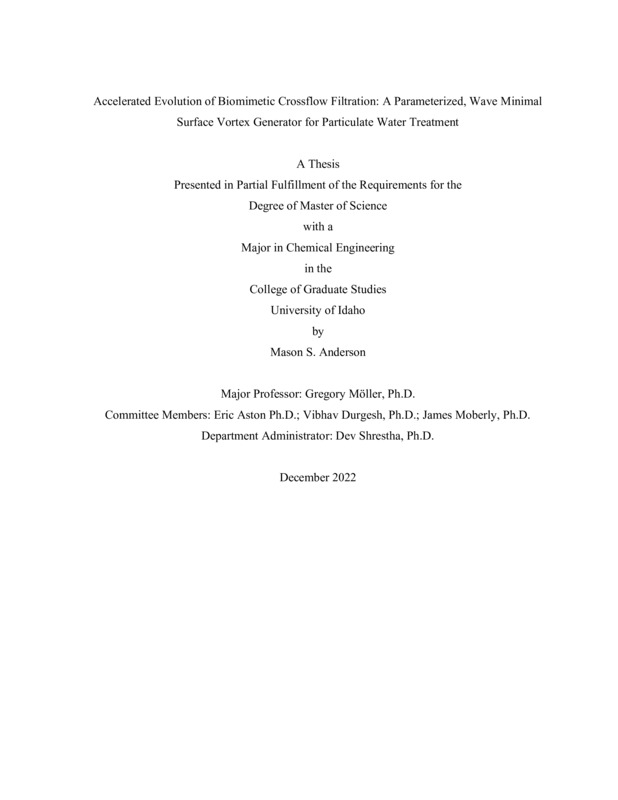Accelerated Evolution of Biomimetic Crossflow Filtration: A Parameterized, Wave Minimal Surface Vortex Generator for Particulate Water Treatment
Anderson, Mason Scott. (2022-12). Accelerated Evolution of Biomimetic Crossflow Filtration: A Parameterized, Wave Minimal Surface Vortex Generator for Particulate Water Treatment. Theses and Dissertations Collection, University of Idaho Library Digital Collections. https://www.lib.uidaho.edu/digital/etd/items/anderson_idaho_0089n_12513.html
- Title:
- Accelerated Evolution of Biomimetic Crossflow Filtration: A Parameterized, Wave Minimal Surface Vortex Generator for Particulate Water Treatment
- Author:
- Anderson, Mason Scott
- ORCID:
- 0000-0001-6653-3502
- Date:
- 2022-12
- Embargo Remove Date:
- 2023-07-24
- Keywords:
- Biomimetic Filtration Minimal Surface Vortex
- Program:
- Chemical & Biological Engineering
- Subject Category:
- Fluid mechanics; Computational physics
- Abstract:
-
Biomimetic crossflow particulate filtration to date has focused on rudimentary replication of biological modalities without extensive considerations for filter surface optimization. The novelty of this current work lies with the utilization of bio-inspired minimal surfaces to facilitate facile topology optimization and empower accelerated evolution. In the present work we analyzed one such classic surface termed the wave minimal surface for its ability to generate vortices for antifouling shear as well as filter particles via vortex-induced shielding. To assess these characteristics, two sets of computational fluid dynamics simulations were conducted and analyzed for planar vorticity, fluid filtrate flux, and particle behavior. Furthermore, the surface was translated into a filter design and parameterized based on three distinctions: leading-edge morphology, angle of fluid incidence, and maximum width. After replicating the simulations for each structural configuration of the filter, the design which produced the highest filtrate flux was 3D printed and tested in a water tunnel for experimental validation. The mid-plane velocity field was analyzed against that of the simulation to determine where the simulation and experiment showed the greatest divergence. The results show that a reversed wave filter design with convex leading-edge, 90° angle of incidence, and maximum width of n=1.0 produced the best filtrate flux for the lowest energy input. The filtrate flux was found to be most sensitive to changes in outlet pressure and less so the velocity of the fluid or the particle diameter. The subsequent validation of this design for inlet fluid velocities ranging from 0.2 to 0.4 m/s produced root-mean-square errors on the order of 0.01 to 0.02 m/s.
- Description:
- masters, M.S., Chemical & Biological Engineering -- University of Idaho - College of Graduate Studies, 2022-12
- Major Professor:
- Moller, Gregory
- Committee:
- Moberly, James; Aston, Eric; Durgesh, Vibhav; Shrestha, Dev
- Defense Date:
- 2022-12
- Identifier:
- Anderson_idaho_0089N_12513
- Type:
- Text
- Format Original:
- Format:
- application/pdf
- Rights:
- In Copyright - Educational Use Permitted. For more information, please contact University of Idaho Library Special Collections and Archives Department at libspec@uidaho.edu.
- Standardized Rights:
- http://rightsstatements.org/vocab/InC-EDU/1.0/

